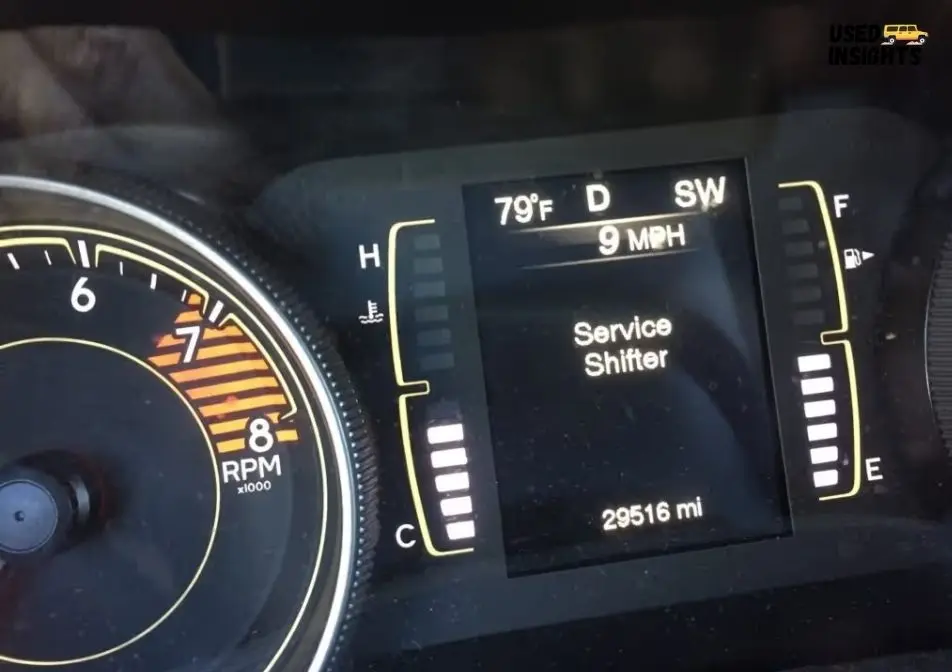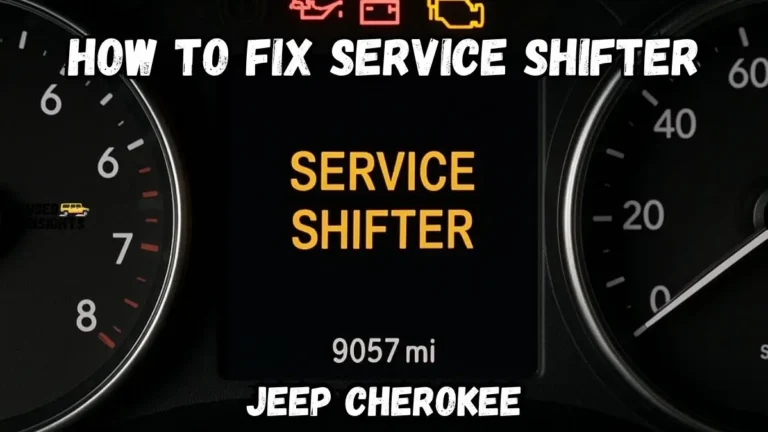The Service Shifter alert is a dashboard notification that activates when your vehicle experiences complications with its gear shifting mechanism. This particular concern has become a recurring problem across Jeep Cherokee models, affecting virtually every model year in the lineup. When transmission shifter complications develop, they create disruptions within the transmission framework and make it challenging for drivers to manage gear transitions effectively.
Most common question for Jeep Cherokee owners, is How to Fix Service Shifter Jeep Cherokee? Typically, the ‘service shifter’ notification emerges between 11,000 to 60,000 miles of vehicle operation, though it can occur beyond these mileage markers. According to reports from Cherokee owners across America, the 2014-2018 model years experienced the highest frequency of shifter-related complications.
While some instances have been resolved through a simple engine restart, many Cherokee drivers have reported recurring shifter problems even after professional repairs. This persistent issue has resulted in multiple legal actions against Chrysler due to the ongoing shifter malfunction concerns.
Recognizing Service Shifter Warning Signs
Primary Indicators
When your Cherokee develops shifter-related problems, you’ll notice several warning signals:
- Service shifter notification displays on dashboard
- Diagnostic trouble codes P1C86-1D or U1465-00 appear during OBD2 scanner analysis
- Red gear indicator lights activate
- Check engine light may illuminate in certain situations
- Transmission operation becomes less efficient
- Gear slipping occurs during operation
- Shifting becomes difficult and requires more effort
- Vehicle may stall unexpectedly during normal driving conditions
Safety Concerns: Can You Continue Driving with Service Shifter Warning?
When the service shifter message first appears on your dashboard, you might not immediately experience driving difficulties. However, continuing to operate your Cherokee with this warning present poses significant safety risks. Vehicle owners should seek professional assistance at an authorized service facility or dealership without delay.
As time progresses, your Cherokee’s overall performance will deteriorate. The most concerning risk is sudden vehicle shutdown while driving, which creates extremely dangerous situations for the driver and passengers, potentially leading to minor or catastrophic accidents.
How to Fix Service Shifter Jeep Cherokee
When Cherokee models encounter gear system component failures, the onboard computer system triggers the service shifter warning indicator. Several underlying causes commonly contribute to this warning message, including electrical connection problems, software malfunctions, defective shifter bezels, insufficient transmission fluid levels, and damaged gear shifter assemblies. Below are detailed explanations of these issues and their corresponding repair solutions with associated costs.
1. Electrical Connection Problems
Understanding the Issue
Modern Jeep Cherokee vehicles feature electronically controlled shifting systems. This configuration requires the Transmission Control Unit (TCU) or Electronic Control Unit (ECU) to receive proper electronic signals from the shifter assembly to function correctly.
When electrical wires connecting these system components become damaged or corrupted, signal transmission fails, resulting in the service shifter warning activation. The bezel harness frequently deteriorates over time, which commonly triggers the service shifter alert. Additionally, problems may originate within the fuse box assembly, requiring comprehensive diagnostic procedures to identify the precise failure point.
Repair Process
Begin troubleshooting by disconnecting all electrical connectors, thoroughly cleaning any accumulated debris from connection points, reconnecting all plugs, and testing the vehicle through engine startup. This basic procedure occasionally resolves the issue.
If the simple fix proves ineffective, perform a complete shifter diagnosis using this systematic approach:
- Position the transmission in park
- Carefully remove the shifter bezel assembly
- Inspect for deteriorated harness connections and remove damaged components
- Install replacement harness connections
- Reinstall the bezel assembly and restart the engine
This repair process typically eliminates the shifter malfunction and prevents the service shifter light from returning.
Repair Investment: Aftermarket gear shifter harness replacements cost approximately $18. Final pricing varies based on local taxes and professional installation fees.
2. Software Malfunction Issues
Understanding the Problem
Your Jeep Cherokee contains a central computing system that manages multiple vehicle functions. Occasionally, software bugs develop within this system, causing gear control malfunctions and triggering dashboard service shifter warnings.
Cherokee models operating with outdated software versions may also experience identical problems. Some vehicle owners have reported recurring issues 6-8 months after dealership service completion, raising questions about Cherokee reliability standards.
Resolution Method
Professional diagnosis at an authorized dealership or qualified automotive technician is essential for addressing software-related problems. Sometimes vehicles require only a basic computer system reset to resolve the malfunction. When system resets fail to eliminate software issues, updating the software becomes the only viable solution.
Outdated software updates present complex challenges requiring specialized dealership equipment and expertise, making immediate professional service necessary.
Service Investment: Software update costs typically range from $250 to $400, depending on service complexity and facility quality standards. Vehicles under warranty coverage receive software updates at no charge to the owner.
3. Defective Shifter Bezel Assembly
Problem Description
The shifter bezel houses gear-related buttons and parking indicator components. Physical damage from cracks or unexpected electrical short circuits can compromise bezel function. Faulty shifter bezels commonly cause service shifter warnings because system communication and proper operation become impossible when bezel failure occurs.
This represents one of the most frequent causes of service shifter warnings, though fortunately, it’s also among the easiest problems to resolve through do-it-yourself replacement procedures.
DIY Repair Steps
When shifter bezel failure occurs, follow these repair steps:
- Engage parking mode
- Remove the shifter’s protective leather covering
- Carefully extract the bezel assembly
- Disconnect the bezel harness from its electrical connection
- Connect the wiring harness to a new bezel assembly
- Reinstall the bezel and replace the shifter cover
If harness damage is discovered during this process, replace those components simultaneously. This repair method eliminates shifter troubles without requiring professional labor expenses.
Component Cost: Multiple aftermarket shifter bezel options are available in various colors and price ranges. Bezel pricing spans from $24 to $140. Professional installation adds modest service charges to the total repair cost.

4. Insufficient Transmission Fluid Levels
Issue Overview
Transmission fluid ensures smooth gear system operation. When fluid levels drop or become contaminated, service shifter warning lights may activate. Low fluid levels also contribute to gear slipping and difficult shifting operations, though insufficient transmission fluid doesn’t always trigger service shifter alerts.
Nevertheless, inadequate fluid levels represent a significant potential cause of service shifter warnings. According to Kelley Blue Book recommendations, transmission fluid should be replaced every 90,000 miles. When fluid replacement schedules aren’t maintained, levels gradually decrease while contamination increases.
Correction Procedure
Begin by checking current fluid levels using a dipstick measurement. If fluid appears dirty or insufficient in quantity, drain the old fluid completely. Refill the reservoir with fresh transmission fluid. Dexron III transmission fluid is the most commonly used and highly recommended option among Cherokee owners.
Fluid Investment: Dexron III fluid pricing in the US market ranges from $9 to $100. Labor costs vary significantly between service providers. Dealership service commands higher labor rates while providing official warranties, whereas independent workshops offer competitive pricing. According to RepairPal.com analysis, complete transmission fluid replacement costs range from $138 to $184, including all associated expenses.
5. Complete Gear Shifter Assembly Failure
Worst-Case Scenario
In extreme situations, the entire shifter assembly may suffer complete failure. When this occurs, vehicle control becomes severely compromised, creating serious accident risks. Immediate shifter replacement becomes absolutely essential for safe vehicle operation.
Complete Replacement Process
Transmission shifter replacement requires these six detailed steps:
- Remove the bezel assembly completely
- Disconnect all electrical harness connections
- Remove the protective gear cover
- Unscrew all bolts securing the shifter assembly in place
- Extract the damaged shifter assembly
- Install the new shifter and reassemble all components by reversing removal steps
Major Repair Investment: New aftermarket transmission shifters can cost up to $1,200, excluding professional installation charges. Final pricing increases based on local taxes, labor rates, and additional service fees. Vehicles experiencing early gear shifter failure during warranty coverage should be serviced at authorized dealerships for free repair or replacement services.
Conclusion
The service shifter warning in Jeep Cherokee models represents a serious concern requiring immediate attention. While some fixes can be performed by experienced DIY mechanics, complex issues involving software updates or complete shifter replacement should be handled by qualified professionals. Regular maintenance and prompt attention to warning signs can prevent minor issues from developing into costly major repairs.


2 comments